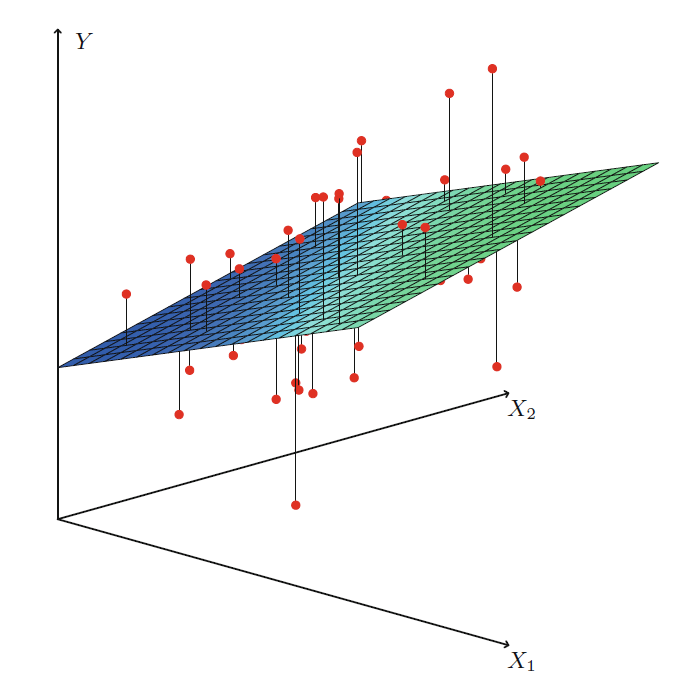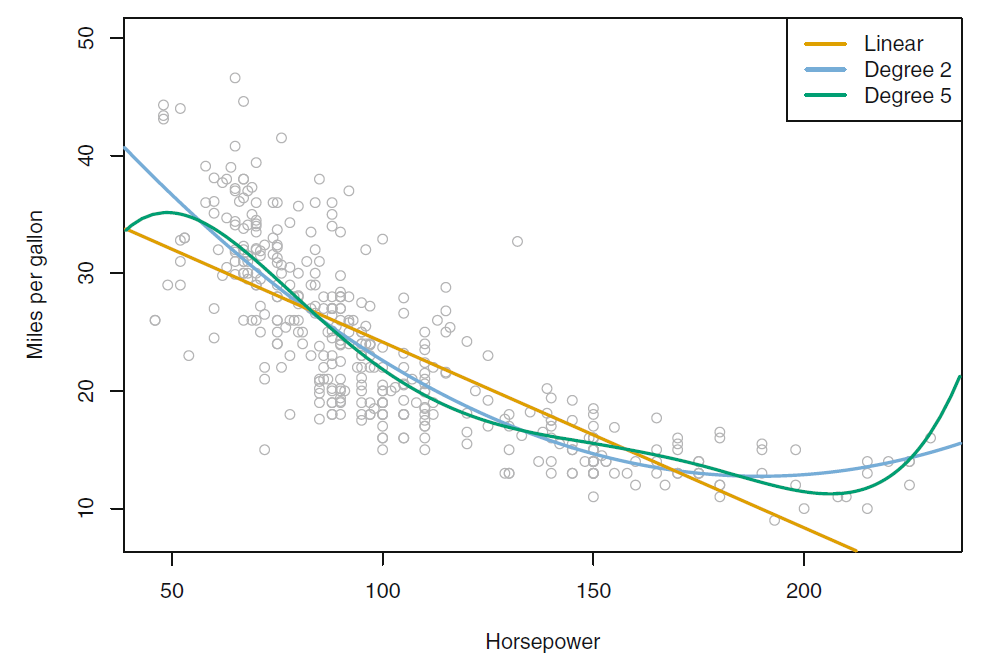 Interpreting Multiple Regression
Interpreting Multiple Regression

- only newspaper adds show no significant correlation to sales
Take care when comparing different models

- If we only consider newspaper adds, they have a significant correlation
- the single equation ignores the other two media in forming estimates for the regression coefficients.
Visualization

2.4.2 Variable Selection

- which predictors should we include in the model?
 Model Selection
Model Selection
- there are models that contain subsets of variables.
- there are different criteria for model quality (, , ...)
- Approaches:
- Forward selection: Start with null model (only intercept ) and add variables
- Backward selection: Start with all variables and remove variables
- More in the next session
 Collinearity
Collinearity
- two or more predictor variables are closely related to one another
- makes difficult to separate out the individual effects
- reduces the accuracy of the estimates of the regression coefficients
- You can spot them in scatter plot matrices
https://medium.com/analytics-vidhya/new-aspects-to-consider-while-moving-from-simple-linear-regression-to-multiple-linear-regression-dad06b3449ff
 Variance inflation factor (VIF).
Variance inflation factor (VIF).
-
Even better: compares how much a variable
adds the to problem
-
The smallest possible value for VIF is 1,
which indicates the complete absence
of collinearity. -
indicates a problematic amount of collinearity.
-
What to do:
- Check VIF for all possible predictors
- drop the predictor with the highest
is the result of regressing on all other predictors
Case Study
If we would like to create a model, that predicts the flipper length not only from bill length but also bill depth, we need to define a model with multiple predictors.
https://www.scoopnest.com/user/AFP/1035147372572102656-do-you-know-your-gentoo-from-your-adelie-penguins-infographic-on-10-of-the-world39s-species-after
 Case Study
Case Study
4.1 Multiple Linear Regression
25 minutes
2.4.3 Qualitative Predictors and further Extensions
 Learning objectives
Learning objectives
You will be able to
- integrate qualitative predictors in regression models
- model non-linear relationships with linear regression
- name common problems when working with linear regression
 Qualitative Predictors
Qualitative Predictors
- so far the models only included quantitative (interval scaled) predictors
- how do we deal with qualitative data
 Predictors with only Two Levels
Predictors with only Two Levels
-
femur length of person
-
 Interpretation of
Interpretation of
- if is negative:
- a woman will be shorter with the same femur length
 Qualitative Predictors with more than two Levels
Qualitative Predictors with more than two Levels
- if the data contains the following ethnicities: Asian, Caucasian, African American
- we would need two additional variables:
- in the models base line, the person is African American so
Example: Input Features that are not numerical
| id | body height | femur length | sex | ethnicity |
|---|---|---|---|---|
| 1 | 185 | 49 | male | caucasian |
| 2 | 176 | 43 | female | asian |
| 3 | 179 | 33 | female | african american |
| ... | ... | ... | ... |
- most models only can work with numerical variables
Dummy Encoding
| id | body height | femur length | is_female | is_asian | is_caucasian |
|---|---|---|---|---|---|
| 1 | 185 | 49 | 0 | 0 | 1 |
| 2 | 176 | 43 | 1 | 1 | 0 |
| 3 | 179 | 33 | 1 | 0 | 0 |
| ... | ... | ... | ... | ... |
- new variables for each category in the original variable
- there is a baseline model (e.g., is male and african american)
- common in linear regression
One-Hot Encoding
| id | body height | femur length | is_female | is_male | is_asian | is_caucasian | is_african_american |
|---|---|---|---|---|---|---|---|
| 1 | 185 | 49 | 0 | 1 | 0 | 1 | 0 |
| 2 | 176 | 43 | 1 | 0 | 1 | 0 | 0 |
| 3 | 179 | 33 | 1 | 0 | 0 | 0 | 1 |
| ... | ... | ... | ... | ... | ... | ... |
- new variables for each category in the original variable
- common in other machine learning models
 Example of a Regression Table with Dummy Encoding
Example of a Regression Table with Dummy Encoding

- the only predictor in is ethnicity (three classes)
- the baseline is African American, where the intercept (predicted value is )
- for both other ethnicity, the model expects a lower value
- however, the correlation is not significant ()
 Case Study
Case Study
 2.4.4 Extensions of the Linear Model
2.4.4 Extensions of the Linear Model
- Linear Regression is a simple, yet powerful tool
- it's the go-to tool in research to evaluate correlation in data
- it's a commonly used model a a baseline for more sophisticated models
- There are two common extensions, that make it even more powerful
 Removing the Additive Assumption
Removing the Additive Assumption

In reality, is it better to spent all the marketing budget on TV or to split it?
- this model is purely additive
- we assume the effects on the sales to be independent
- in reality, we expect synergies (e.g, when people see the add twice)
 by adding Interaction Terms
by adding Interaction Terms
- We can model this, using an interaction term ()
- Interpretation: There is an additional positive effect, if we increase both
(TV and radio adds)
 Interactions with qualitative Predictors
Interactions with qualitative Predictors

prediction of bank account balance from income
- Left Model:
- Right Model:
 Modeling non-linear Relationships with Linear Models
Modeling non-linear Relationships with Linear Models

the linear model is no good predictor for the relationship
 Linear Regression Model can capture non linear Relationships
Linear Regression Model can capture non linear Relationships
- polynomial regression:
- Drawbacks
- we have to decide for the degree of the polynom (parametric model)
- it is harder to interpret
- there are more flexible models
 Case Study: Data Science Project with Linear Regression
Case Study: Data Science Project with Linear Regression
Imagine researching penguin in the Antarctic caused Your scale to freeze an break. However, You still want to get an estimate of the penguins weight.
Luckily, Your colleagues left You with a data set (train) with all the other variables you can measure.
Create a multiple linear regression model to predict the penguins weight. Compare the Mean Squared Error of the model in the test set with your colleagues.
https://www.scoopnest.com/user/AFP/1035147372572102656-do-you-know-your-gentoo-from-your-adelie-penguins-infographic-on-10-of-the-world39s-species-after
45 minutes
